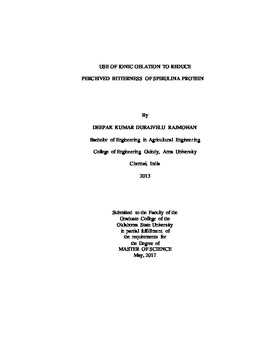| dc.contributor.advisor | Bellmer, Danielle D. | |
| dc.contributor.author | Duraivelu Rajmohan, Deepak Kumar | |
| dc.date.accessioned | 2018-06-13T16:19:49Z | |
| dc.date.available | 2018-06-13T16:19:49Z | |
| dc.date.issued | 2017-05-01 | |
| dc.identifier.uri | https://hdl.handle.net/11244/300054 | |
| dc.description.abstract | Spirulina (blue-green algae) is one of the cheapest sources of protein and essential vitamins. However, bitterness and bad flavor of spirulina protein may limit its use in food products. In this study, ionic gelation was used to facilitate protein delivery and to mask the bitter flavor of the spirulina protein. The objective was to develop a method for encapsulating spirulina protein using sodium alginate, and evaluate its effectiveness in reducing the perceived bitterness of spirulina. Spirulina protein was encapsulated in alginate using both internal and external gelation methods and varying concentrations of sodium alginate and calcium chloride. A total of six different treatments were evaluated. The crude protein was measured using the Dumas method, and the firmness/hardness was measured using a texture analyzer. The morphology was studied using a scanning electron microscope (SEM). The thickness and width of the beads were measured using a digital caliper. The prepared beads were incorporated into cookies to do a sensory evaluation in comparison with untreated spirulina, a standard bitter blocker flavor, and soy protein. Results from analysis of the bead characteristics showed that the beads formed by external gelation were superior to those formed with internal gelation. The hardness of the beads prepared by external gelation was significantly higher than the hardness of the beads prepared by internal gelation. External gelation beads show a more smooth and rigid exterior morphology, whereas internal gelation beads show a soft and heterogeneous exterior morphology. External gelation beads also possess higher protein content than the internal gelation beads. Results from sensory evaluation showed that the color of samples with spirulina-alginate beads was significantly better than the samples with untreated spirulina. However, the panelists felt that the cookies with spirulina-alginate beads were more bitter than other the cookie samples. | |
| dc.format | application/pdf | |
| dc.language | en_US | |
| dc.rights | Copyright is held by the author who has granted the Oklahoma State University Library the non-exclusive right to share this material in its institutional repository. Contact Digital Library Services at lib-dls@okstate.edu or 405-744-9161 for the permission policy on the use, reproduction or distribution of this material. | |
| dc.title | Use of Ionic Gelation to Reduce Perceived Bitterness of Spirulina Protein | |
| dc.contributor.committeeMember | McGlynn, William | |
| dc.contributor.committeeMember | Rayas-Duarte, Patricia | |
| dc.contributor.committeeMember | Ramanathan, Ranjith | |
| osu.filename | DuraiveluRajmohan_okstate_0664M_15055.pdf | |
| osu.accesstype | Open Access | |
| dc.description.department | Food Science | |
| dc.type.genre | Thesis | |
| dc.type.material | text | |
